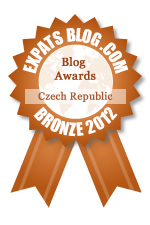By Ricky, on August 23rd, 2009 Catholic Church in Karlovac with partially repaired war damage © Ricky Yates
I’m sorry for the two week delay in posting my final piece about our time in Croatia. Since being back in Prague we’ve had a succession of visitors which has left little time for blogging!
We spent the night of Monday 20th July, our last in Croatia, in the town of Karlovac. Although considerable work has been done to repair the damage caused to buildings in Karlovac during the 1991-95 conflicts that followed the break-up of the former Yugoslavia, there still remains much to do.
The picture on the left is of part of the outside wall of a Roman Catholic Church attached to a Franciscan Monastery in the centre of the town. You can clearly see where holes caused by bullets and shrapnel have been filled in at lower levels whilst higher up, they remain . . . → Read More: Some reflections on the Croat-Serb Conflict
By Ricky, on August 9th, 2009 Sign warning of landmines by the road side between Šibenik & Knin © Ricky Yates
After spending the nights of Saturday 18th and Sunday 19th July in Primošten and exploring Šibenik, we set out on the morning of Monday 20th July on the long journey back to Prague. Having driven down into Croatia on the coast road, we decided to return through the interior. Therefore, once we had reached the outskirts of Šibenik, we headed inland on the road leading to Knin.
From background reading, I knew that we would be travelling through an area that was fought over during the conflict that took place between 1991 and 1995. So I was expecting that we would almost certainly see some remaining war damage. However, what we did observe still did come as quite a shock.
Within 20 km of the coast we saw the first few damaged buildings. . . . → Read More: Journey home through the interior
By Ricky, on July 25th, 2009 St. Donat's Church, Zadar with Roman remains in front © Ricky Yates
Zadar is the largest city on the north Dalmatian coast with a population of around 70,000. Its historic centre lies on a peninsular only 500m wide with a Roman street pattern containing marble paved traffic-free streets and a wealth of Roman remains and historic buildings. Chief amongst these is St. Donat’s Church, an amazing circular building which dates from the beginning of the ninth century.
Although located in Western (Roman Catholic) Europe, the Church is of early Byzantine (Eastern Orthodox) style. What makes it even more fascinating is that it was built over part of the Roman forum that dates from the 1st century BC to the 3rd century AD. Therefore, incorporated into the Church are two complete Roman pillars, together with other stonework containing Latin inscriptions. It is possible to climb a stone . . . → Read More: Zadar
By Ricky, on July 25th, 2009 Dalmatian islands seen from the coast road between Senj and Zadar © Ricky Yates
On Monday 6th July, we drove right across Austria via Linz in the north to Klagenfurt in the south. As we did so, the rain got heavier and heavier so that, as we headed towards the steep mountain pass that would take us into Slovenia, it was positively tipping it down. The weather was no better on the Slovenian side of the border. However, as we joined the motorway to head south towards Ljubljana, (having purchased an expensive vignette to travel relatively few km of motorway), the rain slowly started to ease. And having bypassed Ljubljana and travelled on to Postojna where we left the motorway for the somewhat windy road that leads to the Croatian border, the sun came out as though to welcome us to our holiday destination.
At the . . . → Read More: Mistaken Identity
|
rickyyates.com is a participant in the Amazon Services LLC Associates Program, an affiliate advertising program designed to provide a means for sites to earn advertising fees by advertising and linking to Amazon.
|



Recent Comments